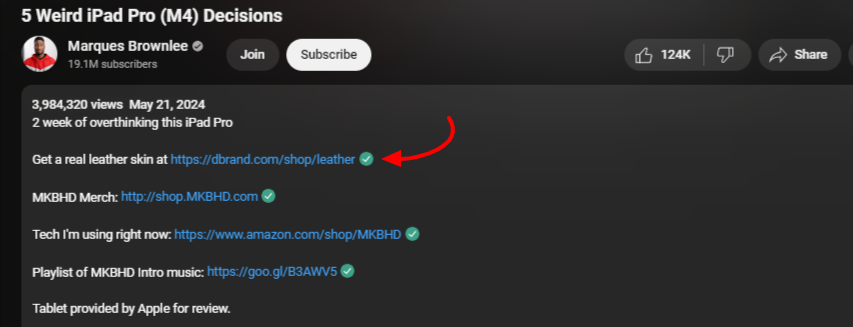Contenido
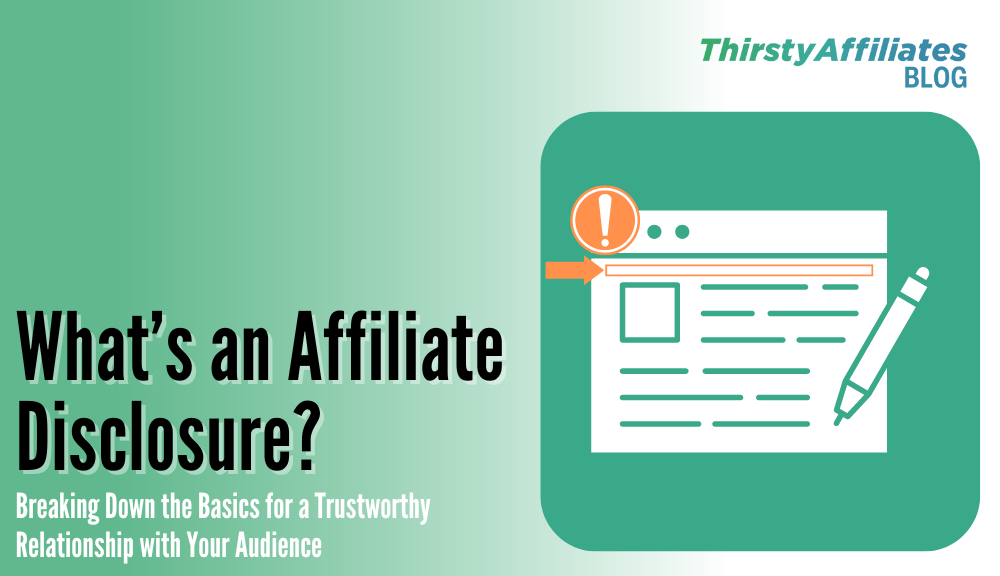
Acaba de conseguir la asociación de afiliación perfecta y su contenido está listo para generar comisiones. Pero hay un elemento crucial que no puedes pasar por alto: la declaración de afiliación.
Es más que una formalidad; es un elemento clave de transparencia que puede generar confianza en su público y mantenerle conforme a la normativa.
Pero, ¿qué es exactamente una declaración de afiliación y por qué es tan importante?
Las declaraciones de afiliación pueden parecer pequeños detalles, pero desempeñan un papel importante en el mundo del marketing de afiliación. Entender los entresijos de estas declaraciones puede marcar una gran diferencia en tu credibilidad y éxito.
En este artículo, trataremos todo lo que necesita saber sobre la información de afiliación. Te explicaremos por qué son una parte esencial de las promociones de afiliación, qué dice la normativa y cómo puedes elaborar declaraciones claras y eficaces que te mantengan en el lado correcto de la ley y en el buen lugar de tu público.
¿Qué es una declaración de afiliación?
Una declaración de afiliación es una declaración que informa a su público sobre sus relaciones de afiliación.
Cuando incluya enlaces de afiliación en su contenido, debe informar a sus lectores de que puede ganar una comisión si realizan una compra a través de estos enlaces. Esta transparencia es crucial para generar confianza en su público y cumplir la normativa legal.
La información sobre los enlaces de afiliación puede adoptar diversas formas. Pueden ser una breve declaración al principio o al final de una entrada de blog, una página dedicada en su sitio web o una simple nota incluida junto a cada enlace de afiliado.
Tanto si su objetivo es aumentar su transparencia, protegerse legalmente o simplemente mejorar la confianza de sus lectores, comprender las declaraciones de afiliación es imprescindible para cualquier vendedor afiliado de éxito.
¿Por qué es importante tener uno?
Disponer de una declaración de afiliación es importante por varias razones:
1. Cumplimiento legal: Organismos reguladores como la Comisión Federal de Comercio (FTC) en Estados Unidos exigen a los afiliados que revelen sus relaciones con los comerciantes. No hacerlo puede acarrear consecuencias legales, incluidas multas y sanciones. Las directrices de la FTC tienen por objeto garantizar que los consumidores no sean engañados y puedan tomar decisiones de compra con conocimiento de causa.
2. Construir la confianza de su público: La transparencia es fundamental para generar y mantener la confianza de su público. Cuando revelas tus relaciones de afiliación, demuestras a tu público que eres honesto y digno de confianza. Esto puede aumentar la fidelidad y el compromiso a largo plazo. Es más probable que los lectores confiar en sus recomendaciones si saben que eres sincero en cuanto a ganar una comisión.
3. Aumentar la credibilidad: La divulgación de un enlace de afiliado aumenta su credibilidad como creador de contenidos. Demuestra que está comprometido con prácticas de marketing éticas y que valora la honestidad. La credibilidad es crucial en la era digital, en la que los consumidores son cada vez más exigentes. escéptico ante las recomendaciones en línea. Al ser transparente, demuestra su integridad y profesionalidad.
4. Evitar sanciones y pérdida de programas de afiliación: De acuerdo con la ley, la mayoría de los programas de afiliación le exigen que revele sus enlaces de afiliado como parte de sus condiciones de servicio. El incumplimiento de estos requisitos puede conllevar la expulsión del programa de afiliación, la pérdida de las comisiones y otras sanciones.
Incluir la divulgación de un enlace de afiliado en su estrategia de marketing es esencial. Garantiza el cumplimiento de las normas legales, fomenta la confianza y la credibilidad de su público y respalda las prácticas de marketing éticas.
¿Quién necesita una declaración de afiliación?
Cualquiera que utilice enlaces de afiliados en sus contenidos debe incluir información sobre las filiales. Esto incluye:
- Blogueros y creadores de contenidos: Si usted gestionar un blog o crear contenidos que incluyan enlaces de afiliación, debe revelar sus relaciones de afiliación.
- Influenciadores de los medios sociales: Influenciadores que compartir enlaces de afiliados en plataformas sociales como Instagram, YouTube, Twitter o TikTok deben revelar los vínculos de asociación. Esto incluye añadir descargos de responsabilidad en las descripciones de los vídeos, en las publicaciones o incluso en el propio contenido.
- Propietarios de sitios web: Los sitios que utilizan el marketing de afiliación, incluidos los sitios especializados, los sitios de reseñas y los sitios de comercio electrónico, deben incluir un enlace de afiliación.
- Email Marketers: Si usted enviar boletines o correos electrónicos de marketing que incluyan enlaces de afiliación, debe revelar estas afiliaciones en el contenido del correo electrónico.
- Podcasters y creadores de vídeo: Creadores de contenidos que utilizan enlaces de afiliados en sus podcasts o descripciones de vídeo también deben revelar estos enlaces. Esto puede hacerse mediante la inclusión de declaraciones por escrito en el notas del programa o descripciones de los vídeos o verbalmente en la grabación.
En pocas palabras, cualquiera que desee monetizar sus contenidos con enlaces de afiliados deben incluir una declaración de afiliación junto a sus promociones.
Cómo divulgar correctamente los enlaces de afiliación
La aplicación de una información adecuada puede resultar complicada, sobre todo si se tienen en cuenta los distintos requisitos de las diferentes plataformas.
Para ayudarle a navegar por este aspecto esencial de marketing de afiliaciónhemos recopilado algunas buenas prácticas generales y consejos específicos para diferentes plataformas.
Tanto si escribes en un blog como si publicas en las redes sociales o creas contenidos de vídeo, estas directrices te permitirán divulgar los enlaces de afiliación de forma eficaz y conforme a la normativa.
Buenas prácticas para divulgar correctamente los enlaces de afiliación
1. Sea claro y visible: Su declaración de afiliación debe ser fácilmente visible. Colóquela donde los lectores la vean sin tener que buscarla. Evita enterrar la información en un párrafo largo o al final de un post.
2. Utilice un lenguaje sencillo: La información debe ser sencilla y fácil de entender. Evite la jerga o la jerga legal. Su público debe comprender inmediatamente que usted puede ganar una comisión si realizan una compra a través de sus enlaces.
3. La coherencia es la clave: Asegúrese de incluir su declaración de afiliación cada vez que comparta un enlace de afiliado. La coherencia refuerza la transparencia y la confianza.
4. Alinearse con su marca: Adapte su divulgación a adaptarse a la voz y el estilo de su marca. Tanto si su tono es informal, profesional o humorístico, asegúrese de que su divulgación se perciba como una parte natural de su contenido.
5. Siga las directrices legales: Los distintos países tienen normativas específicas sobre la divulgación de afiliación. Familiarícese con las directrices de su jurisdicción, como las de la FTC en Estados Unidos, y asegúrese de que su información cumple estos requisitos.
Consejos de divulgación de afiliación para diferentes plataformas
Entradas de blog
- Divulgación previa y posterior: Comience la entrada de su blog con una breve declaración. Por ejemplo: "Antes de entrar de lleno en este artículo, tenga en cuenta que algunos enlaces de esta entrada son enlaces de afiliados. Si compra a través de estos enlaces, puede que gane una comisión sin coste adicional para usted. Gracias por apoyar mi blog".
- Divulgación en el contenido: Incluya la divulgación dentro del propio contenido, especialmente cerca de los enlaces de afiliación. Esto garantiza que los lectores sean conscientes de la relación de afiliación. en cuanto encuentren el enlace. Por ejemplo: "Echa un vistazo a este magnífico producto (enlace de afiliado). Si decides comprarlo, puede que gane una pequeña comisión".
- Divulgación post-scriptum: Termine la entrada de su blog con una nota de divulgación para recordar a los lectores. Por ejemplo: "Posdata: Este artículo contiene enlaces de afiliados. Si realiza una compra a través de estos enlaces, ganaré una pequeña comisión. Gracias por su apoyo".
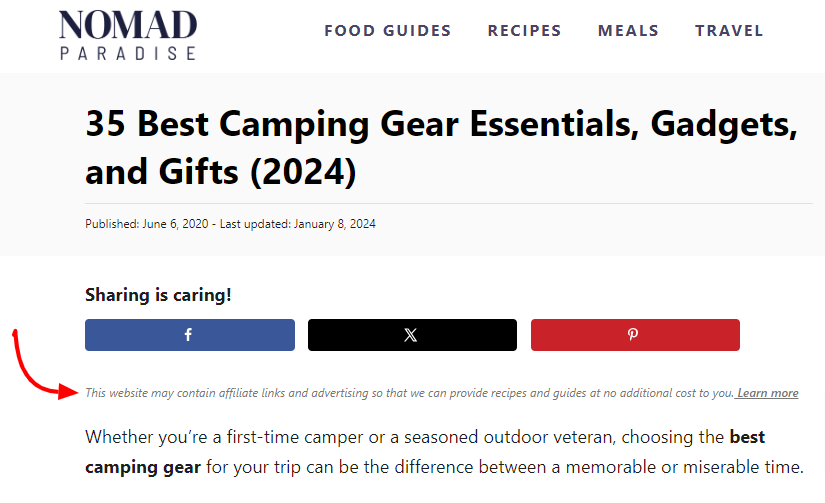
💡Más información en Por qué deberías monetizar tu blog con el marketing de afiliación
Redes sociales
- Hashtags: Utiliza hashtags claros como #ad, #affiliate o #sponsored para revelar enlaces de afiliación en plataformas como Facebook, Instagram y X. Por ejemplo, "¡Me encanta mi nueva ropa de entrenamiento! #ad #affiliate".
- Información a pie de página: Incluye una breve declaración en el pie de foto de tu publicación. Por ejemplo, "Puede que gane una comisión si compra a través de estos enlaces. Gracias por apoyar mi contenido".
- Bio Divulgación: Coloque una divulgación permanente en su biografía en las redes sociales. Por ejemplo, "Enlaces de afiliados incluidos. Gano una comisión por las compras sin coste adicional para ti".
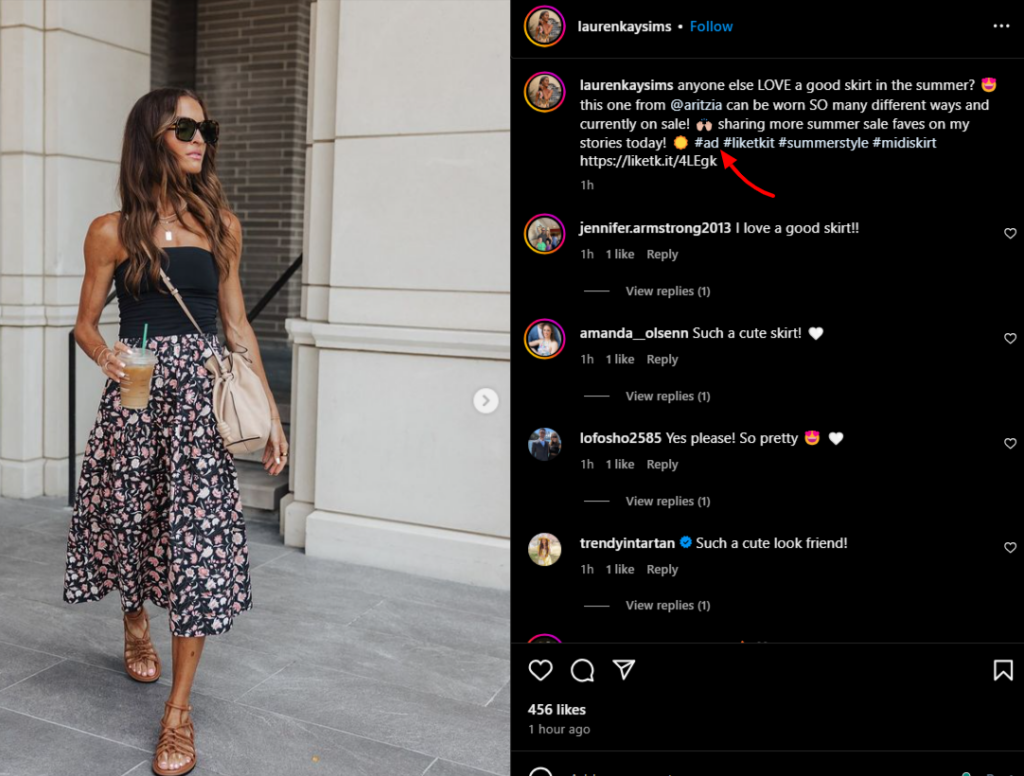
💡Más información en Cómo promocionar enlaces de afiliados en las redes sociales
Podcasts y contenidos de vídeo
- Divulgación verbal: Indique claramente su divulgación al principio o al final del vídeo. Por ejemplo: "Para que lo sepas, este episodio contiene enlaces de afiliados. Si compra a través de estos enlaces, puede que gane una comisión sin coste adicional para usted."
- Descripción Caja Divulgación: Incluya una declaración por escrito en el cuadro de descripción del vídeo. Por ejemplo: "Este vídeo incluye enlaces de afiliados. Si usted compra a través de estos enlaces, gano una pequeña comisión. Gracias por tu apoyo".
- Divulgación en pantalla: Muestre una breve información en pantalla durante el vídeo, especialmente cuando muestre el enlace de afiliado. Por ejemplo, "Enlace de afiliado: Puedo ganar una comisión si compra a través de este enlace".
💡Más información en Cómo hacer marketing de afiliación para podcasts
💡Más información en Cómo promocionar enlaces de afiliados en YouTube
Boletines por correo electrónico
- Firma de correo electrónico: Añada una declaración de divulgación a su firma de correo electrónico. Por ejemplo, "Nota: Este correo electrónico contiene enlaces de afiliados. Gano una pequeña comisión si realizas una compra, sin coste adicional para ti".
- Divulgación por correo electrónico: Incluya una breve declaración al principio o al final del contenido de su correo electrónico. Por ejemplo, "Algunos enlaces de este correo electrónico son enlaces de afiliados. Si haces clic y realizas una compra, puede que gane una comisión. Gracias por su apoyo".
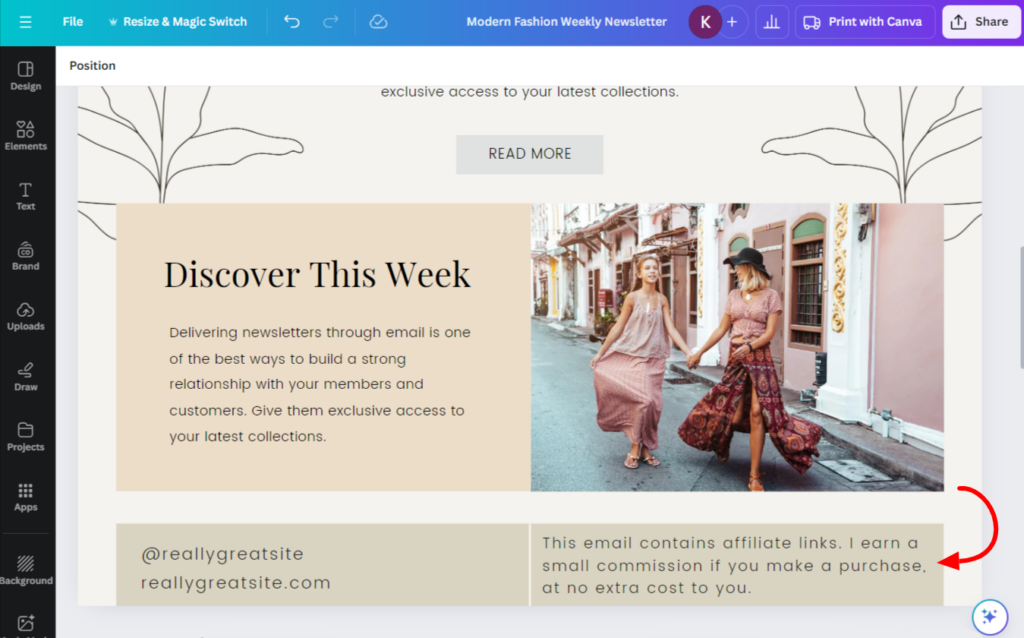
💡Más información en Cómo aumentar las ventas de los afiliados con el marketing por correo electrónico
Deje que ThirstyAffialites se encargue de las divulgaciones de enlaces de afiliados en su sitio web
Imaginamos que estás ocupado creando contenidos increíbles, y lo último de lo que quieres preocuparte es de asegurarte de que todas tus divulgaciones de afiliación están en su lugar.
Aquí es donde interviene ThirstyAffiliates para simplificarle la vida y mantener su sitio web conforme a las directrices de la FTC.
Colocación automática de información
Con ThirstyAffiliates, no tiene que añadir manualmente declaraciones de divulgación a cada entrada o página. Automatiza este proceso, garantizando que aparezca un aviso de divulgación en la parte inferior de cada contenido.

Además, las divulgaciones pueden incluirse automáticamente en expositores de productosAsegúrese de que sus enlaces de afiliación sean siempre transparentes.
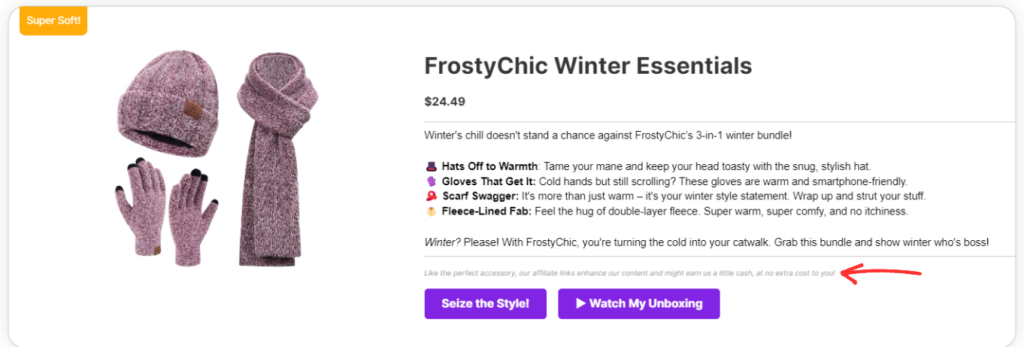
Estas funciones de automatización le ahorran tiempo y garantizan la coherencia en todo su sitio, para que pueda centrarse en lo que mejor sabe hacer: crear contenidos valiosos para su audiencia.
Información sobre herramientas personalizable
Supongamos que escribes una entrada en tu blog sobre tus gadgets tecnológicos favoritos e incluyes varios enlaces de afiliados. ThirstyAffiliates le permite activar un icono junto a estos enlaces que muestra un mensaje de divulgación cuando se pasa el ratón por encima.
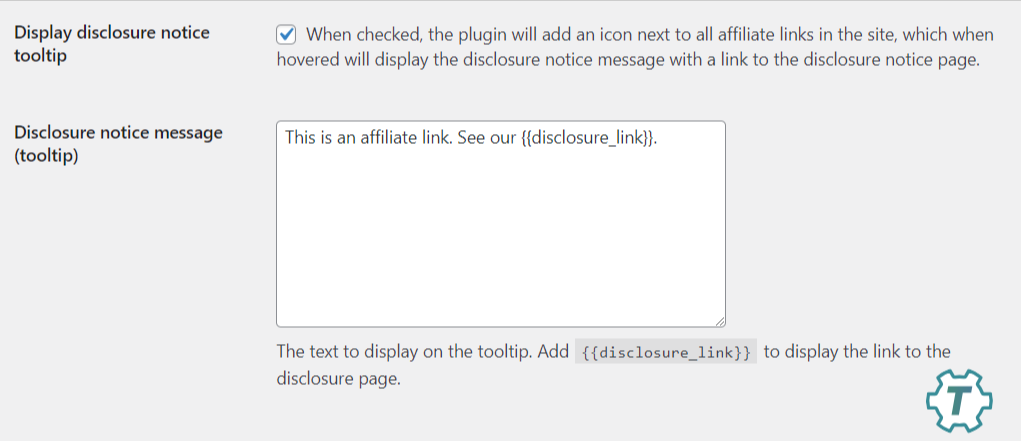
Esto no sólo le permite cumplir las normas, sino que también se integra perfectamente en su contenido sin interrumpir el flujo de sus lectores.
Mensajes de divulgación personalizados
Usted tiene una voz de marca única, y sus divulgaciones deben reflejarlo. ThirstyAffiliates le permite personalizar el texto de sus mensajes de divulgación.
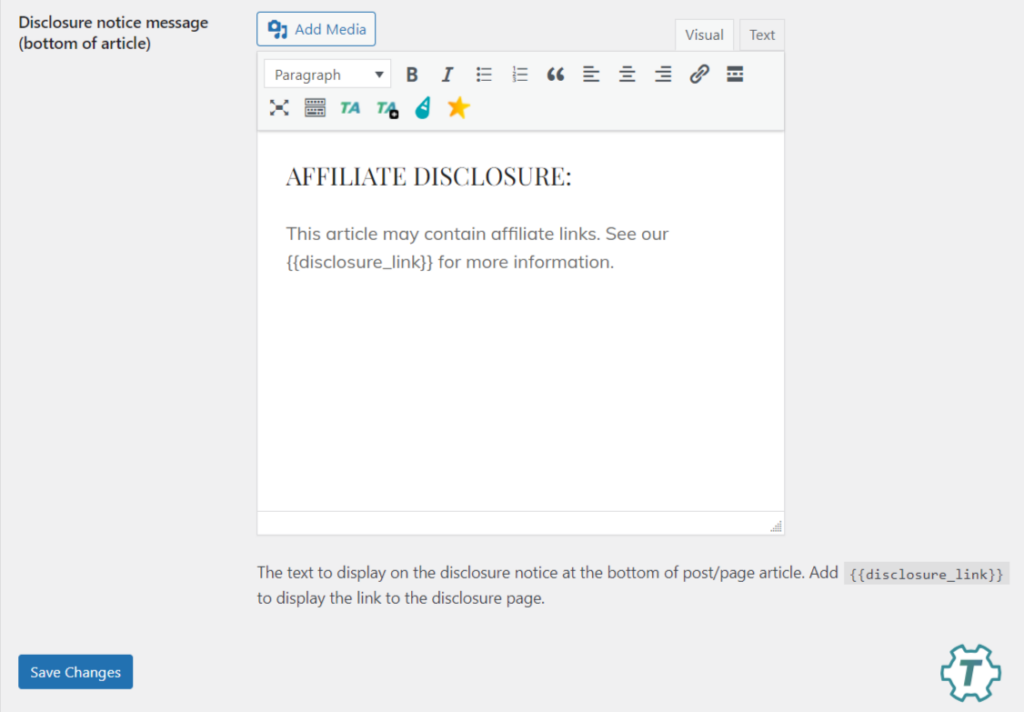
Tanto si prefiere un tono amistoso y desenfadado como un enfoque más formal, puede adaptar los mensajes para que se ajusten perfectamente a su marca.
Personalización del texto de los enlaces
Si tiene una página dedicada a la divulgación, puede personalizar el texto del enlace que dirige allí a sus lectores.

Esto hace que sea claro y accesible, proporcionando toda la información que necesitan acerca de sus relaciones de afiliación de una manera sencilla.
Conclusión
Revelar enlaces de afiliación no tiene por qué ser una tarea pesada. Siguiendo las mejores prácticas, como ser claro, coherente y alineado con la marca, crearás un vínculo más fuerte con tu audiencia.
ThirstyAffiliates simplifica esta tarea con divulgaciones automatizadas y personalizables, garantizando que cumpla la normativa sin esfuerzo. Esto le permite centrarse en la creación de un gran contenido mientras mantiene a su audiencia informada y comprometida.
Con ThirstyAffiliates, la transparencia se convierte en parte integrante de su estrategia, permitiéndole hacer lo que le gusta sin preocuparse de los detalles legales.
Si te ha gustado este post, no dejes de seguirnos en Twitter, Instagram, Facebook, Pinteresty LinkedIn¡! Y no olvides suscribirte en el recuadro de abajo.

